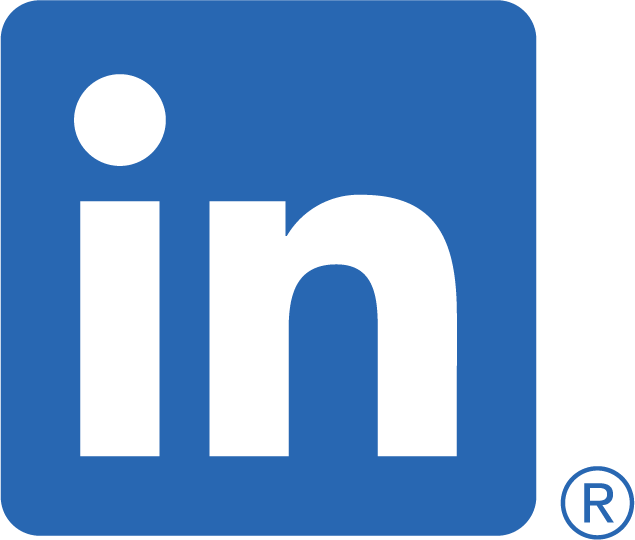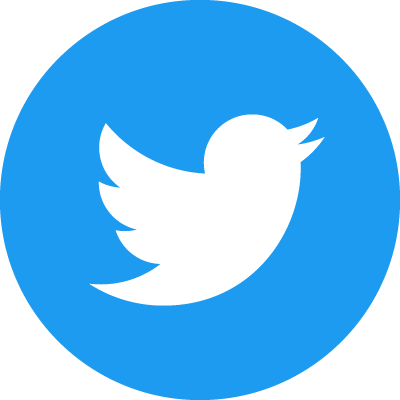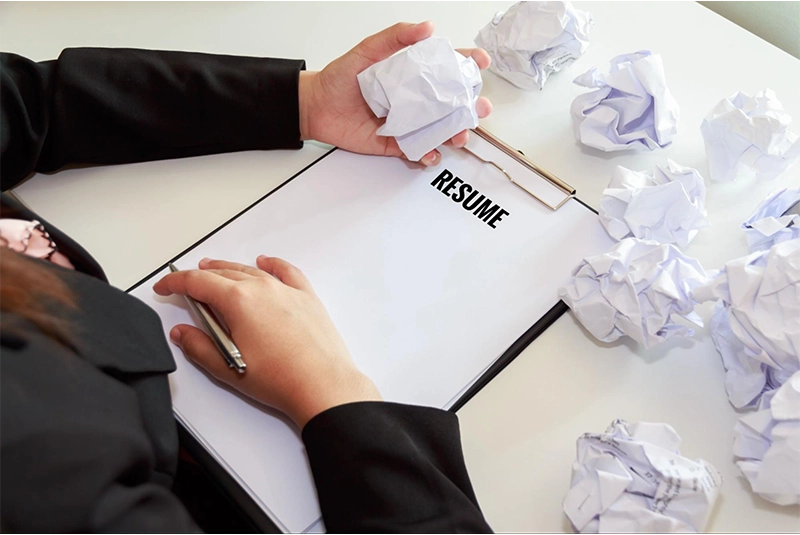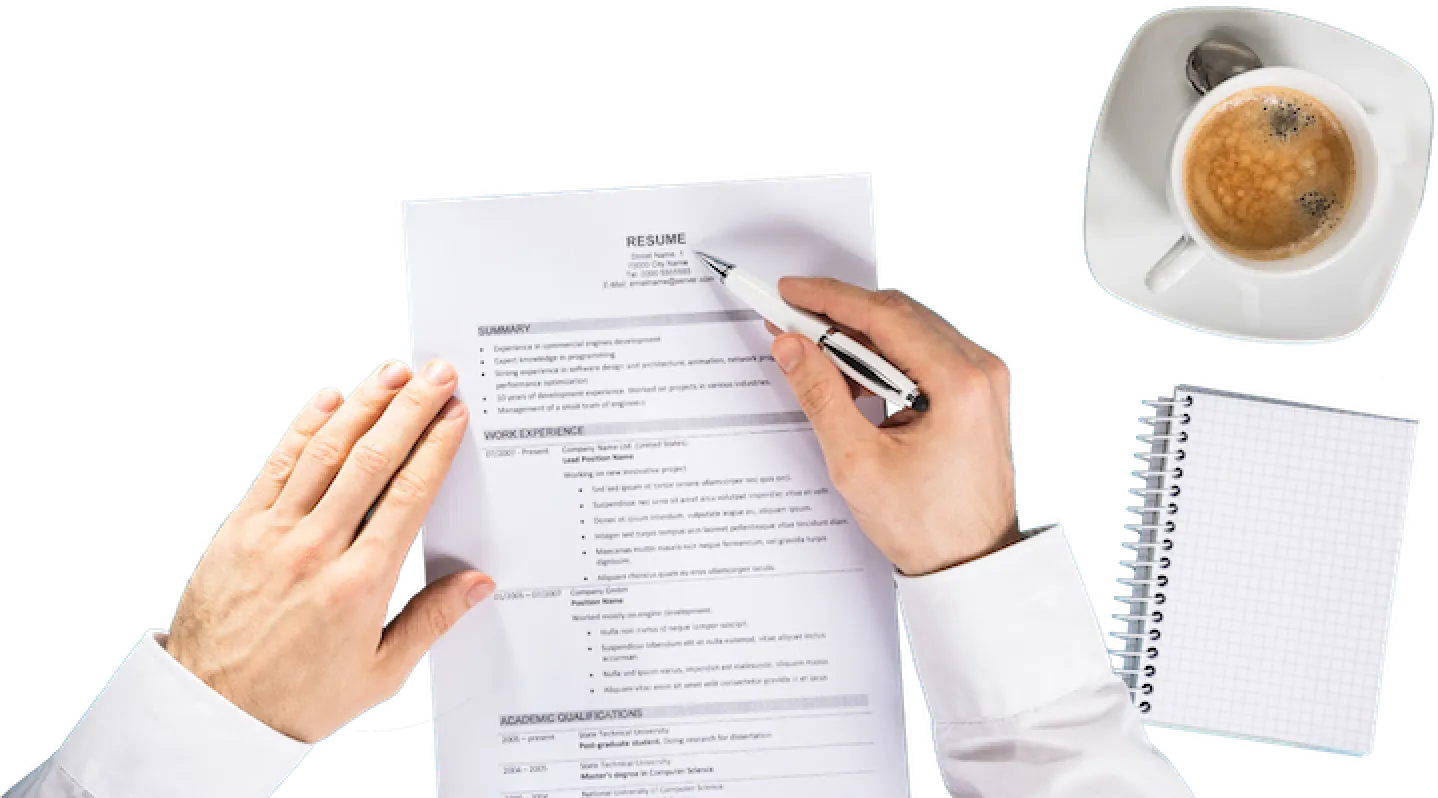If there’s a job you want, you’ll need an exceptional resume to land an interview.
These days, it’s not about a thesaurus-inspired vocabulary or writing your life story in a cover letter. In fact, the first set of “eyes” on your resume might not even be human. So you need a resume that can please all audiences and make the best first impressions.
Luckily, there’s a straightforward process to writing a resume that gets more interviews. From the millions of resumes we’ve read and written, we’ve created this step-by-step guide to writing a winning resume for the modern job market.
In this article, we’ll show you what to include in your resume, what kind of details interest recruiters the most, and how to optimize your resume for more interviews and job offers.
Ready to get started? Let’s go!
Step 1. Choose a resume format
A quick search on “resume formats” pulls up a myriad of ideas of which resume format is the best, but there’s really only one format worth using. Reverse chronological is the only acceptable format for your resume.
Why? Let’s take a closer look at the most popular alternatives to find the answer: chronological and functional.
The chronological resume format lists your job experience in order from the very beginning. If you’ve been moving up the ladder in the last few years and are now applying for a more senior position, it doesn’t make sense to make your reader start with your most entry-level experience. By the time they reach the good stuff, you’ve likely already lost their attention.
The functional resume format puts an emphasis on your skills rather than your experience. While skills are an important part of your resume, they don’t tell a recruiter enough about you for them to call you for an interview. The truth is, you’re probably not the only applicant who is a “detail-oriented problem solver with a proficiency in MS Office.” It’s going to take more than that to stand out.
Why reverse chronological format is best
The reverse chronological format keeps the emphasis of your resume on your most relevant experience while putting everything into a simple, easy-to-read format.
This format allows you to paint a picture of your work experience with concrete proof of your skills and capabilities. Just take a look at this Software Engineer resume example to see this concept in action:
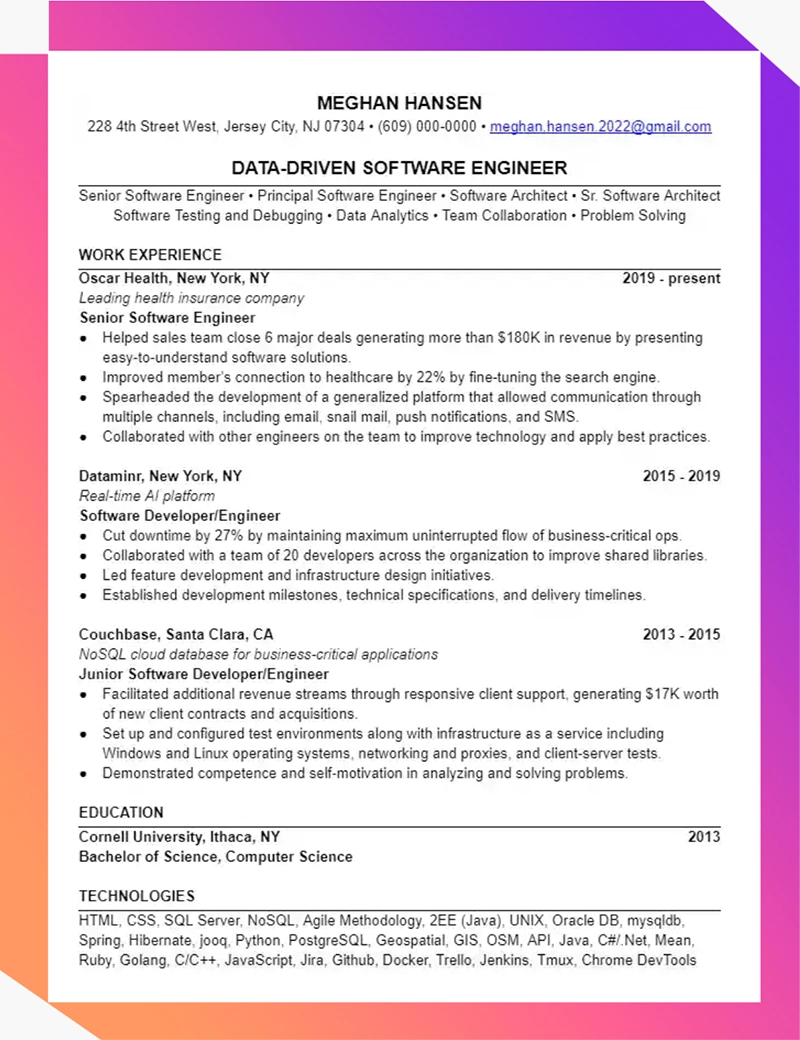
By listing your most recent (and most relevant) jobs first, your resume paints a picture of where the next logical step of your career should be—which is in the job position you’re applying for, of course.
Tip: Stay away from fancy resumes
You might be tempted to spend hours experimenting with different visual elements and unique formats for your resume, but don’t. Fancy formatting will not improve your resume. (That goes for all you creatives out there, too.)
Your resume should be optimized for your four audiences: the screener, the recruiter, your future employer, and the applicant tracking system (ATS) or resume parser.
Since it only takes an average of 7.4 seconds for a recruiter to assess your resume, those creative formats, colors, and fonts only get in the way of your success. Plus, headshots, charts, graphs, and any other graphics or images will be ignored by the ATS, potentially sending your resume to be misfiled.
Any person (or computer) that reads your resume is looking for your qualifications and what makes you a good fit for their open position. The easier you make their job, the better your chances of moving to the next round of the hiring process.
Do yourself a favor, and keep it simple.
Step 2. Add your contact info and other personal details
Your contact information should be complete, accurate, and centered (not left justified) at the top of your resume. This lets the reader know that this is, indeed, a resume and they’re starting at the right place.
This is the contact information to include in your resume:
- Full name
- Phone number
- Location (city, state, ZIP code)
- Email address
Avoid adding any images of yourself, unnecessary social profiles, or other media. These things will only distract your audience from the substance of your resume and take away space from the content that’s likely to get more interviews.
Take this Nursing Quality Director resume, for example.
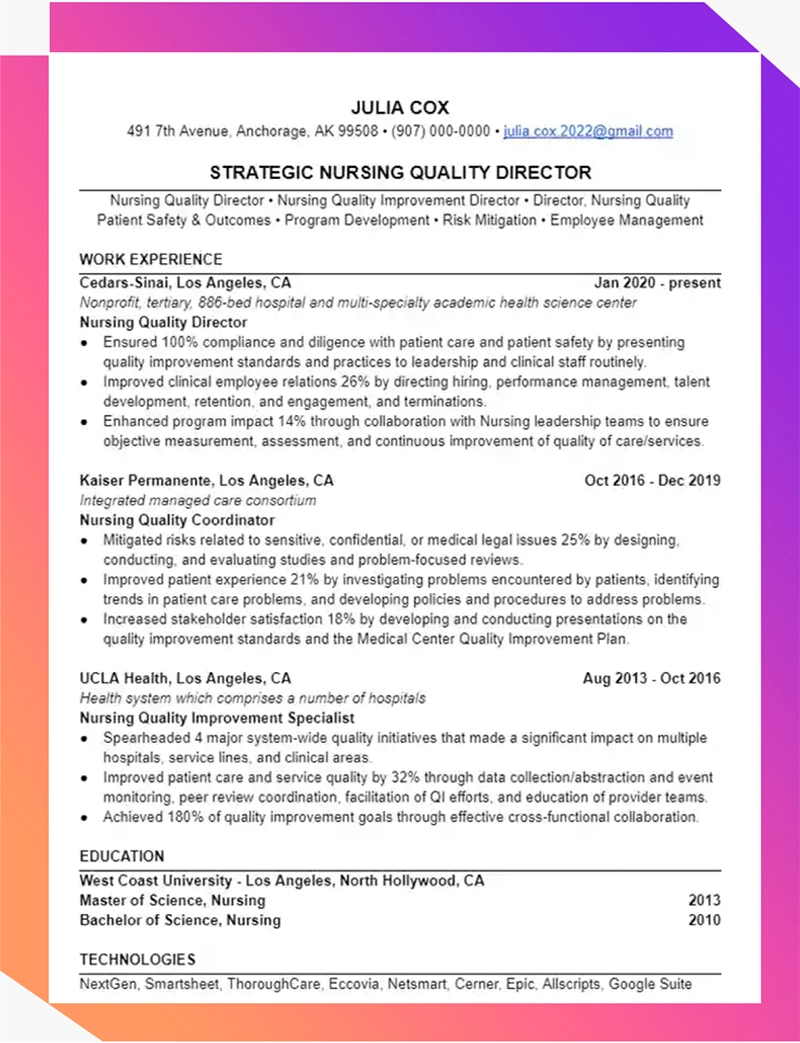
It may not be the most graphically stunning, but it gets the job done. And when the company is deciding who to call back for an interview, they’ll know exactly who they’re calling and the contact information is easy to find.
Tip: Don’t abbreviate your name, and make sure your address is complete
To avoid any confusion that might move your resume to the “do not call” pile, use your full name and spell out your location.
For example, if you live in Muncie, Indiana, you’ll want this information to be clear and in plain text.
Parsers and applicant tracking systems use your city, state, and other contact information to find candidates in specific locations. Be sure to use an address that is both complete and up to date.
Step 3. Perfect your Professional Headline
Your Professional Headline announces who you are as a candidate, and it comes right before your Professional Summary (we’ll discuss that next).
This should read a bit like a job title for your career so far: three to four words that sum up everything you are on a professional level in bold and ALL CAPS. And it should begin with an adjective that makes you look good, like “innovative,” “seasoned,” or “expert.”
Here are some examples of great Professional Headlines:

See the full Business Development Manager Resume Example

See the full Accountant Resume Example

See the full Personal Assistant Resume Example
Instead of simply declaring your job title, Professional Headlines like this give your audience an idea of the type of candidate you are and which qualities you consider to be the most valuable in your position.
In a sea of “accountants,” be the accountant with a little more personality.
Tip: You can be creative … but not too creative
You want a screener or ATS to be able to quickly identify who you are as a candidate, so don’t bury your position beneath distracting adjectives.
While descriptors like “accomplished” or “turn-around expert” add human qualities and useful perspective on the basic facts of your career, avoid being abstract or over-the-top. Don’t call yourself a “guru,” “wunderkind,” or “Jedi.”
Step 4. Add your Professional Summary
Don’t be fooled by the little space your Professional Summary consumes on your resume. You should spend at least a third of your resume writing time on your Professional Summary.
This is the place to tell all four audiences exactly who you are as a candidate—and it’s where you’ll make the most powerful and targeted pitch for the job you want.
Just like an elevator pitch, your Professional Summary should be thoroughly reviewed and scrutinized until it’s absolutely perfect. How perfect? It’s worth spending a few hours to get it just right, seeing as it’s where you describe the essence of who you are as a candidate.
Keep everything in your Professional Summary short and succinct. This section is designed to quickly depict you as the most qualified candidate for the job.
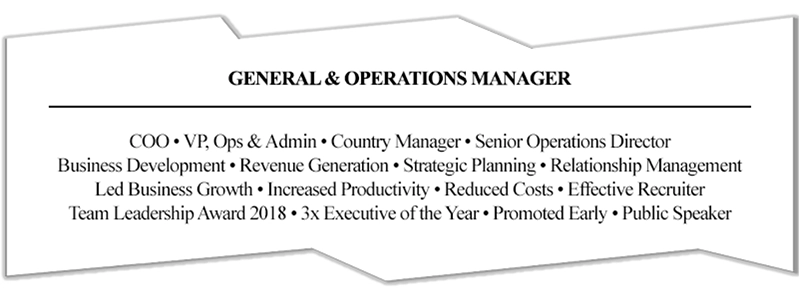
Professional Summary example by Ladders
The professional summary consists of four lines:
- Your next job titles, meaning job titles you’d accept at your next position
- Your professional skills
- Notable skills and achievements
- Awards and recognitions, industry considerations
Let’s take a closer look at what to include for each of these.
First line
The first line is for listing a few job titles you’d accept for your next role to let recruiters know what you want to do next.
These don’t need to be titles you currently hold or have held in the past, but they do need to be reasonable in relation to your work experience.
If you’re currently an IT Support Specialist, listing Lead or Senior Support Specialist would be appropriate, whereas listing Chief Information Officer without the necessary experience or qualifications would not.
Second line
Listing the most relevant professional skills you’ve acquired in your career is how you show all four audiences that you’re a great match for their open position.
How do you know which skills are relevant?
A great place to start is by scanning the job description. The skills they’re looking for will often be listed here. Combine those with a few highlights from your unique skill set, and you can make your Professional Summary really stand out from the other applicants.
Third line
Showing is always better than telling. That’s why the third line of your Professional Summary should acknowledge a few key accomplishments from your work history.
While you could simply state that you’re a great team leader, showing your recruiter that you led the highest-performing sales team for six straight quarters tells your recruiter a lot more.
Fourth line
To end your Professional Summary with an exclamation point, list your key achievements and relevant professional awards from your career in the fourth line.
While your skills and accomplishments may be noteworthy, having others recognize your work accentuates those professional highlights even more.
Example of a Professional Summary
Let’s take another look at that Professional Summary:

Notice that there are no complete sentences or long phrases. This is one of the things that makes the Professional Summary far more effective than the traditional resume feature, the objective. The key is to keep the reader reading, and this format is the best way to do that.
Note: If you’re just starting out in your profession, we suggest reducing your Professional Summary from four to two lines. (For more advice on writing a technical resume, read this article.)
Tip: Consider company size when listing the job titles you want
Keep your audience in mind when you’re listing your desired job titles.
While you may believe that your experience as CFO at a tech startup for three years has prepared you for the same role at Google, their hiring manager will likely need more convincing.
Maybe that’s a little extreme (sorry, Ruth), but the notion remains true. Think of how each previous role and job title compare with your prospective company and make your selections accordingly.
Step 5. Add ATS-friendly skills and keywords to your resume
Your resume’s first audience probably won’t be human. The ATS or automated parser likely will be the first gatekeeper for your resume.
An ATS is an AI-driven system that scans your resume for specific keywords and other parameters such as location or experience. Choosing the right keywords for the ATS comes down to using simple phrases and common nouns.
It’s important to make the computer’s job as easy as possible so your resume isn’t overlooked or misfiled.
Remember, these parsers are not impressed by your fancy formatting skills and will ignore any graphic elements you choose to include (don’t include any, please).
Keep all your information written in plain text to allow the machines to effectively index your data so recruiters can find you.
Since you know that the ATS will be programmed to look for certain keywords, use the posted job description and your knowledge of the position to choose the most relevant keywords and skills for your resume.
Tip: Don’t use a PDF (Use Microsoft Word of Google Docs instead)
Scanned resumes and PDFs are image files, not text files. Since the data of most PDFs are locked, HR departments are required to use a PDF reader to extract the text from your resume. Adding this unnecessary step is counterproductive for anyone who wants to get hired.
Instead, use Microsoft Word or Google Docs to create and send your resume. These text files are easy to read by any software and ensure that your resume gets assessed before any PDF resumes.
Step 6. Showcase your work experience
Your resume is more than just a transcript of your career.
The work experience section of your resume is an opportunity to show hiring managers that you’re the best person for the job—and that’s not done by dryly listing all your duties and responsibilities at every job you’ve ever held.
Use this space with intention and avoid mentioning obvious tasks. If you’re a Sales Team Manager, managing the sales team is a given.
Instead, use this space to show the positive impact you made in these previous roles. The goal is to highlight your work experience in a way that reads like a sizzle reel of your professional career. A big part of this is replacing simple action verbs like “manage” with strong success verbs (more on that in a bit).
In this resume example for a Sourcing Specialist, you can see how the applicant begins each bullet with an exciting success verb like “optimized,” “boosted,” and “improved,” to highlight their value in each role.
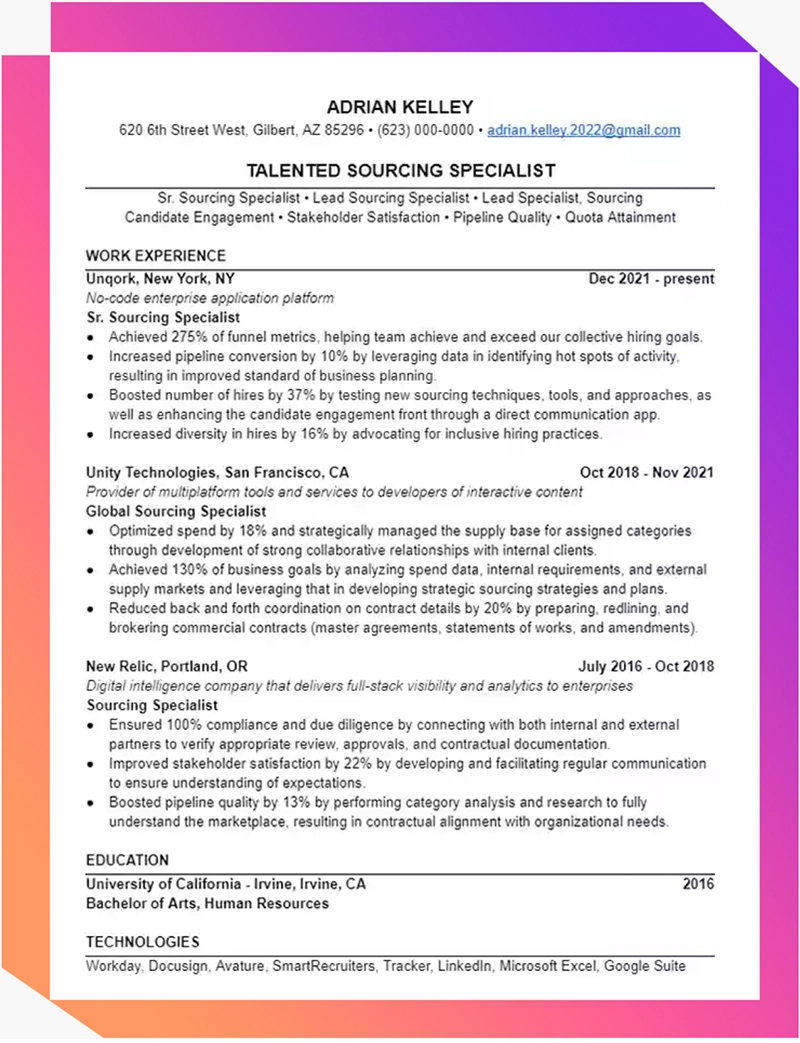
They also pair these success verbs with numbers and figures to paint an exact, quantifiable picture of their contributions. Whether it’s units, dollars, or percentages, adding numbers to your work experience gives context to your success verbs and adds credibility to your claims.
How long to make the work experience section of your resume
If you’ve been in your career for 10 or more years and are using a two-page resume, you can use up to 25 bullet points in your work experience section. If you’re less than a decade into your career, use 10-15 bullet points and restrict your resume to one page.
If you’re using 25 bullets, allocate them to different periods of your career based on importance. Since this is a reverse chronological resume, try using 10-15 bullets for the last five years, five bullets for the five years before that, and five bullets for the remainder of your relevant work experience.
Any work experience older than 15 years should be omitted from your resume.
Tip: Use a different success verb for each bullet point
You don’t want to simply tell your reader that you completed a job or task. You want to show them how exceptionally well you performed at that position and the success you brought to your employer. As they say for fiction writers, “show, don’t tell.”
This is where success verbs come in.
Success verbs are an invigorating element for your resume and get a potential employer excited about you repeating your success for their organization.
While action verbs simply list what you do, success verbs imply the positive impact of your work before you’ve even mentioned the details.
So instead of words like “managing,” “performed,” “established,” or “defined,” try these 25 success verbs with your 25 bullet points (and leave the thesaurus on the shelf).
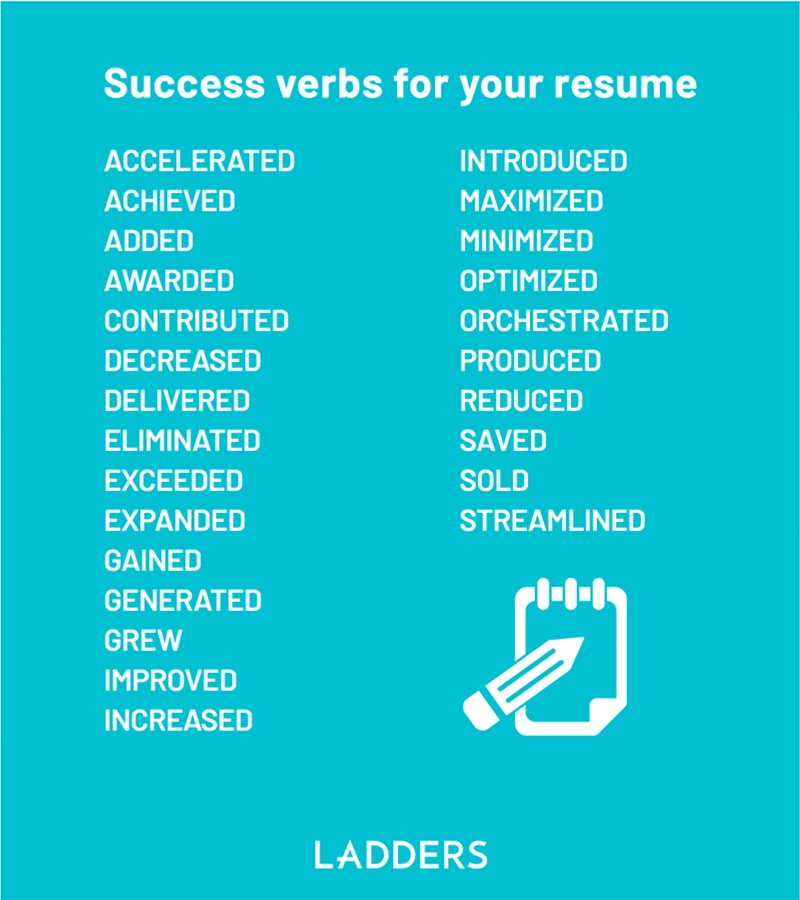
Find out more about the magic of success verbs here.
Step 7. Manage any gaps in your work experience
There are plenty of reasons why you may have a notable absence in your work experience. Whether you took time off to raise a family, were dismissed from a job, or retired, it’s best to get ahead of any questions and manage any gaps in your work history proactively.
While a gap of 12 months or more is never seen as a positive in job recruitment, there are ways to present these gaps in a positive light.
First, acknowledge the gap. Include the unemployment gap as a bullet point entry in your work experience to address it preemptively.
If you did any sort of non-profit, consulting, or freelance work in your time off, describe it here (with a strong success verb).
When you don’t have an institutional connection like one of these, just paint this time period with a brief and positive description of the gap while showing optimism and excitement for getting back into the workforce.
For example, if you spent a few years at home raising a family, you might include one bullet point entry like:
- Stay-at-home mom of four, excited to organize, multitask, and mentor in the workforce. 2015-2022.
Or, for unfortunate and unexplainable unemployment gaps, try something like:
- Energized to return to the workforce after a period of learning and personal growth. 2019-2022.
Whatever the reason for your gap in employment, stay positive and brief. Even though recruiters and hiring managers will be interested in the reason for this gap, handle it with optimism and keep the focus on the rest of your work experience. There are still plenty of reasons why you might be an attractive candidate.
Tip: Don’t stress over COVID-related furloughs
Many in the workforce had some career fluctuations due to the pandemic, so if you were laid off from your job or something happened to the company where you were formerly employed, hiring managers will understand and not hold this against you.
Step 8. Include your real skills
If your objective is to advance your career with your next job, the skills you use in your current role will be less relevant. On the other hand, your recruiter will judge your fit based on the skills you’re trying to develop and perfect today.
Only include skills that point to your potential and readiness to advance to the next level. For example, as a Software Engineer, if you are learning Node.js, machine learning, or enhancing your data structures know-how, include these in your resume.
The coding languages you are currently working with won’t give you as much leverage as the new languages you are learning.
Hiring professionals today look for transferable skills. This means that although you don’t have direct work experience for the post you are applying for, your skills make you eligible.
For example, a nurse can get a role as a lecturer in a biology department even if they have never worked in education. The reason being that the candidate possesses the required skills if not work experience.
Skills play a vital role in your resume. Some candidates focus on listing their qualifications while ignoring their skills. Or worse, they just copy and paste it from someone else’s resume.
In today’s ever-changing job market, your skills are more important to a recruiter than your degree. And in many big enterprises, people with a bachelor’s degree or less are supervising people with master’s degrees and doctorates.
Let’s look at the Software Engineer Resume again. The Technologies section at the bottom of the page takes up much more space than the Education section. And it makes sense why, especially considering the technical nature of a Software Engineer role.

Similar to your work experience, don’t list skills that are too obvious or are synonymous with the job. For example when applying for a Senior Software Engineer job, listing skills like “master at Microsoft Excel” is not what your recruiters want to read.
If you don’t already have that skill, it would be very interesting to know how you became a computer programmer in the first place!
If you’re a Software Engineer looking to advance your career, you should include only the most relevant and applicable skills for the role.
Soft skills can be just as important as technical skills. In the past, there were no metrics or ways to accurately evaluate a candidate’s people skills. Today, modern hiring agencies use sophisticated tests to determine how developed your interpersonal skills are. Recruiters give a lot of weight to the results of these tests. If you’re an excellent coder but can’t work with others, the hiring manager will likely choose another candidate.
Many universities today offer soft skills development courses. Mentioning a certificate for these if you have it will make your resume more balanced. And a balanced resume will be more attractive to potential employers.
If you’re a Software Engineer, the second line of your Professional Summary, where you list your skills, should mention things like critical thinking, leadership, problem-solving, and professional writing.
The reason professional writing skills may give you an edge is that, while the company may have numerous skilled Software Engineers, they may lack someone who is skilled at writing technical documentation and replying to emails.
Finally, just as you should never fabricate qualifications or work history on your resume, you shouldn’t lie about skills either.
According to a survey conducted by Monster.com, 85% of recruiters believe candidates exaggerate their skills and competencies. And the bitter truth is that sooner or later these lies and misrepresentations will cost them heavily.
Many hiring agencies contact a candidate's previous bosses for recommendations. If they disagree with the skills and qualities mentioned on the resume, the candidate can miss their chance.
It’s wise and professional to stick to the most real, relevant skills. If your skill set is a bit thin, learn some new things! Lying is not going to help.
Tip: Don’t keyword-stuff your skills to trick the ATS
Listing each and every skill you’ve acquired, including those not relevant to the job, is going to do more harm than good.
Keyword-stuffing here will get your resume noticed by an automated parser, but that’s about as far as it will get. And even then it might be misfiled. Once a recruiter sees it, they will not like a crowded or a cluttered resume. And they’ll see through your attempts to game the ATS and blacklist you.
Instead of muddying the process with a lot of irrelevant keywords, be honest, accurate, relevant, and real. The parser will be better able to forward your resume to the right places, and the first human that reads it will know exactly what you have to offer without having to search through the haystack.
Filling your resume with lower-level or irrelevant skills won’t help you get interviews for the jobs you really want.
Step 9. Add education and certifications
While job history that’s more than 15 years in the past won’t get you past screeners or impress recruiters, your educational history will always be relevant. Your certificates are your long-term assets. They always have a value in the eyes of a talent scout.
While certificates and degrees aren’t as powerful on a resume as experience and quantifiable skills, they do help. Especially if you’re earlier in your career and don’t have much work experience. Degrees and certifications can also lead to higher pay. The Bureau of Labor Statistics (BLS) reported that in 2020 the median weekly wage for employees with certifications was $1,307, and for those who lacked certifications it was $913.
List all higher education degrees and certifications in your resume. Also mention all the training courses you’ve had that are relevant to your career path.
List the universities or colleges where you pursued your credentials, and on the same line to the right mention your years of attendance and graduation dates.
Look at how this Teacher resume lists education details.
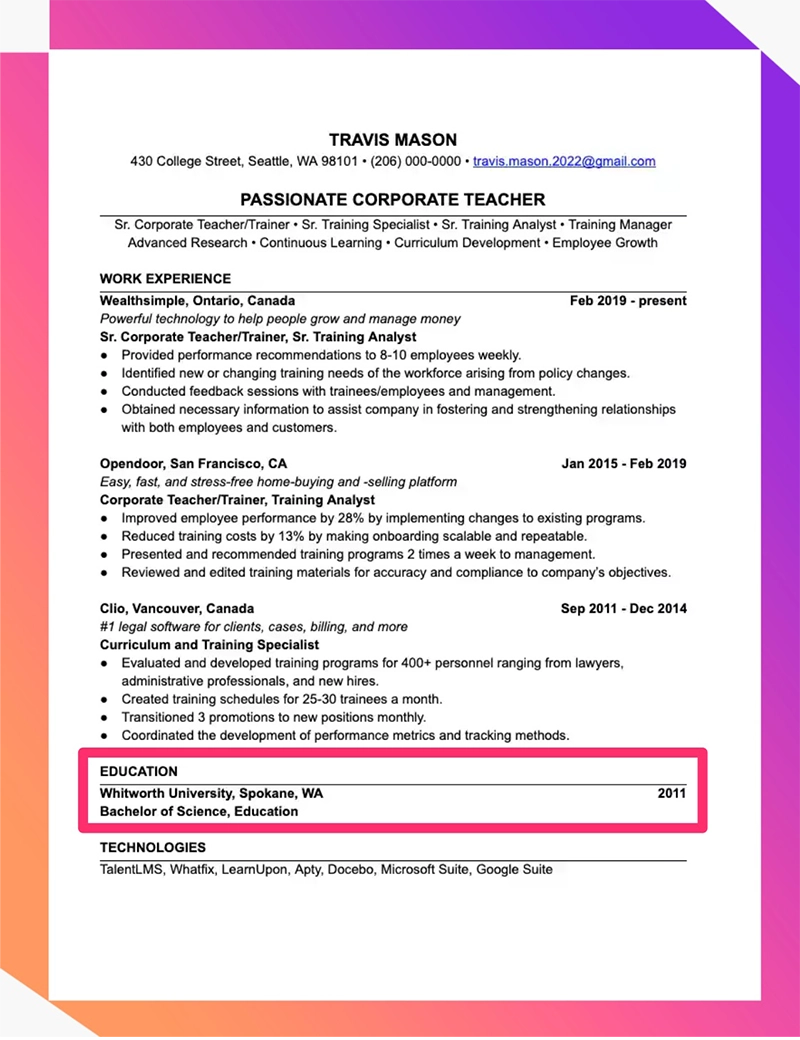
Double check the name of your degree and make sure it’s the official name. Also pay close attention to dates and other information to make sure they are the same on your diploma or certificate.
Tip: Do not embellish
Resist the temptation to embellish your place of study or fib about the honors you received. Lying about your degree is much more severe in the eyes of recruiters than fabricating your Skills section. Any exaggerations or even typing errors in your Education section are very likely to catch up to you.
Your reputation will be damaged and you will lose the job opportunity if you are discovered fibbing about the certifications mentioned in your resume.
Step 10. Make sure your resume is simple and clear
Before you send out your resume, read it with a critical eye. Simplify any sentences or phrases that are overly complex. Clarify anything that’s ambiguous. Articulate anything that you only implied.
Amid hundreds of job applications, a simple and clear resume stands out because it is distinctly understandable.
- Use clear, concise statements
- Add success verbs to achievements and quantify them with numerical values
- Use 25 bullets if you’re writing a two-page resume, and 10-15 bullets if your resume is one page
- Use appropriate and useful keywords
- Avoid lengthy paragraphs
While automated parsers can sometimes read between the lines, the right keywords are essential for them to effectively index the data.
And if your data is incomplete or unreadable by a parser because it’s in a jpeg or a PDF file, your resume may never make it to a recruiter.
As you go back through your resume, look for typos, spelling mistakes, and grammatical errors. These will hurt your job chances because they will annoy the reader, and they may point to a lack of attention to detail or even bring into question your basic skills.
If a candidate is not particular in their resume, they may be even less responsible in their job.
Tip: Keep your resume dull (visually)
We have mentioned this, but because it’s critical it bears repeating: use a simple format for your resume. Don’t use fancy templates (even if you’re in a creative field), and leave out any graphics.
Resist the urge to use eye-catching illustrations, callouts, and infographics to make your resume stand out in the eyes of recruiters. The recruiter likely will never see it because it won’t get past the ATS. And even if it does, simple and easy to read is always better.
The visual aspect of your resume is one place where being a cookie-cutter clone of everyone else isn’t a bad thing.
Stand out through your successes, accomplishments, and skills. Because only these will make your resume effective and give you the best chance of landing the job you want.



